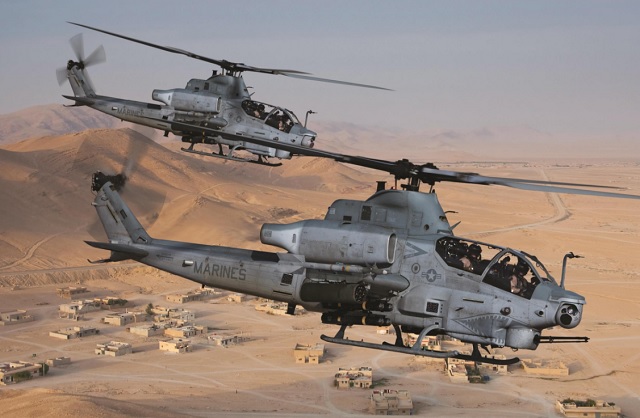This is not your grandfather’s Huey. That is the message H-1 programme officials at US Naval Air Systems Command (NAVAIR) want potential foreign and domestic customers to know as they consider the latest UH-1Y and AH-1Z models, named Venom and Viper.
The H-1 Huey (Iroquois) first flew in October 1959 and the AH-1/Model 209 Cobra lifted off six years later in September 1965, with both types playing an important role in the Vietnam War.
Today, four-blade, twin-engine versions produced by Bell Helicopter in Amarillo, Texas serve as the primary light utility and attack helicopters of the US Marine Corps, with ruggedised composite airframes designed specifically for the most corrosive salty and sandy environments.

Bell UH-1Y Venom
US Marine Corps
Production of the 160 UH-1Ys and 189 AH-1Zs (349 total) began ramping up in 2007 to replace the UH-1N Twin Huey and AH-1W SuperCobra. USMC Col Steven Girard of the H-1 programme office (PMA-276) says production of the UH-1Y is winding down, with final deliveries expected in fiscal year 2018. Production is now transitioning to the AH-1Z, which uses 85% common components. Bell has 166 H-1s left to deliver to the Marines and in 2015, it secured a foreign military sales case with Pakistan for the AH-1Z.
Girard says additional orders would help bolster production and keep the unit cost down as the Marine Corps completes its programme of record and transitions wholly to AH-1Z production by FY2019.
Pakistan has been approved for up to 15 Vipers, and NAVAIR says the programme office also has documented interest from Bahrain, the Czech Republic, Poland, Australia, UAE, Croatia, Brazil and Malaysia.

AH-1Z and UH-1Y
Bell Helicopter
“Most of them are competitions and the vast majority are for the AH-1Z,” Girard said during a media briefing at the Navy League’s Sea-Air-Space exposition in Washington DC on 16 May. “There are a couple for the UH-1Y and we’re in the [request for information] stage, answering questions back and forth with those countries at this point.”
The UH-1Y model is lightly armed with 7.62mm and 12.7mm calibre machine guns and 70mm guided rockets. The AH-1Z carries up to two AIM-9 Sidewinders, 16 AGM-144 Hellfires, 650 rounds of linkless 20mm ammunition, 76 Mk-66 70mm rockets and 28 laser-guided "advanced precision kill" rockets.
Girard says there is currently no interest from American national guard units, but one opportunity does exist to replace the UH-1N aircraft owned by the US Air Force. The service plans to hold a competition for up to 72 aircraft under a Huey recapitalisation effort that is funded in its FY2017 budget submission.
“It would be great if they went from the November to the Yankee,” says Girard. “It would definitely help, because the more aircraft we have, the costs are going to be spread out.”

Bell Helicopter
In terms of product improvements, H-1 light attack product integration team lead David Baden says the programme office is looking at degraded visual environment (DVE) systems for safer operations in brownout conditions as well as digital interoperability improvements for better data sharing with ground forces, other aircraft and unmanned aerial vehicles. Baden was speaking during a teleconference briefing at the American Helicopter Society (AHS) International conference in West Palm Beach, Florida on 19 May.
Source: FlightGlobal.com



















